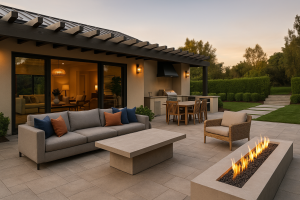In the world of dining establishments, the design of a restaurant is essential. An experienced restaurant architect is responsible for conceptualizing, planning, and executing the design of a dining establishment’s interior and exterior spaces. They possess a unique skillset that blends creativity and technical expertise, ensuring that the restaurant’s design is both visually appealing and functional.
In this section, we will explore the role of a restaurant architect and provide a comprehensive understanding of what they do. We will delve into their key responsibilities, the importance of their expertise in restaurant design, and the various aspects they oversee in the creation of dining establishments. So, if you have ever wondered what a restaurant architect is and what they do, you have come to the right place.
The Role of a Restaurant Architect in Designing Dining Establishments
A restaurant architect plays a crucial role in designing dining establishments. Whether it’s a small cafe or a large-scale fine-dining restaurant, the restaurant architect works to ensure that the space is functional, efficient, and aesthetically pleasing. From the initial concept to the final construction, the architect oversees every aspect of the design process.
The Importance of Restaurant Design
Restaurant design is essential to creating an enjoyable dining experience for patrons. A well-designed restaurant should reflect the concept and vision of the establishment, creating an ambiance that complements the cuisine and atmosphere. The layout should also be optimized to maximize table turnover and flow of traffic, while maintaining a comfortable and open space for guests to dine.
Responsibilities of a Restaurant Architect
Restaurant architects are responsible for transforming the client’s vision into a functional and aesthetically pleasing space. They work closely with clients to understand their requirements and incorporate them into the design process. This includes understanding the target audience, menu offerings, and desired ambiance.
The architect then develops the restaurant layout and selects materials for the interior design. They also optimize the flow of the restaurant to enhance the overall dining experience. Additionally, the architect considers the functional aspects of the restaurant, such as the commercial kitchen design and safety regulations.
The Collaborative Process
Creating a successful restaurant design is a collaborative process between the architect and the client. The architect will take into consideration the client’s input and work to ensure that the design meets their expectations. During the design process, the architect will provide drawings and renderings to help the client visualize the final product.
The architect will also work with contractors during the construction process to ensure that the design intent is implemented accurately. They manage the timeline and budget, and ensure the quality of materials and workmanship meets the design specifications.
In summary, the role of a restaurant architect is to create a functional, aesthetically pleasing, and optimized space for diners to enjoy. They work closely with clients to understand their vision and requirements, and oversee every aspect of the design process from concept to construction.
The Role of a Restaurant Architect in Designing Dining Establishments
A restaurant architect is responsible for transforming an empty space into a functional and aesthetically pleasing dining establishment. They work with clients to understand their vision and create a design that caters to their needs while adhering to industry standards and regulations. The role of a restaurant architect in designing dining establishments is multifaceted, encompassing several key responsibilities.
Collaborating with Clients and Gathering Requirements
A critical aspect of a restaurant architect’s role is collaborating with clients and gathering their requirements. This involves understanding their vision, target audience, desired ambiance, menu offerings, and budget. The architect will work closely with the client to create a design that meets their expectations while also fitting within their budget and adhering to industry standards and regulations.
The architect will also consider factors such as the location of the restaurant, the size of the space, and any existing structures or equipment that will need to be incorporated into the design. This collaborative process ensures that the final design meets the needs of the client and maximizes the potential of the space.
Designing the Restaurant Interior and Layout
The interior design of a restaurant is an essential aspect of creating a welcoming and comfortable environment for patrons. A restaurant architect is responsible for designing the layout of the restaurant, selecting materials, and optimizing the flow of the space to enhance the overall dining experience. They must also consider factors such as accessibility, safety regulations, and ventilation systems.
The architect will create a floor plan and design the seating arrangement, considering factors such as the number of patrons and the type of cuisine. They will also select materials such as flooring, lighting, and furniture that complement the design concept while maximizing durability and functionality.
Ensuring Functional Commercial Kitchen Design
A well-designed commercial kitchen is critical for the smooth operation of a restaurant. A restaurant architect is responsible for ensuring that the kitchen is functional, efficient, and meets safety regulations. They must consider factors such as the workflow, equipment placement, and ventilation systems.
The architect will collaborate with the chef and kitchen staff to understand their requirements and design a kitchen layout that maximizes efficiency and productivity. This may involve selecting specialized equipment, designing custom storage solutions, and creating functional workspaces.
Overall, the role of a restaurant architect in designing dining establishments is crucial for creating a functional, aesthetically pleasing, and profitable dining experience. Their expertise in restaurant design and architecture can help clients bring their vision to life while optimizing the potential of the space.
Designing the Restaurant Interior and Layout
One of the primary responsibilities of a restaurant architect is to design the interior of a dining establishment and create a layout that optimizes the space for both patrons and staff. A well-designed restaurant interior can enhance the dining experience by creating a comfortable and visually appealing atmosphere, while an efficient layout can improve productivity and workflow.
When designing the restaurant interior, a restaurant architect considers numerous factors such as the desired ambiance, target audience, and menu offerings. They also select appropriate materials, colors, and lighting fixtures to create a cohesive and aesthetically pleasing space that aligns with the restaurant’s brand identity.
Additionally, a restaurant architect must optimize the flow of the restaurant to ensure that patrons can move around comfortably and efficiently. They carefully consider the placement of tables, seating arrangements, and the positioning of service stations to enhance the overall dining experience.
Selecting Materials
Choosing the appropriate materials for the restaurant interior is critical to creating a cohesive and visually appealing space. A restaurant architect selects materials that match the restaurant’s brand identity and design concept while also ensuring durability and ease of maintenance. For example, if the restaurant has a rustic feel, the architect might incorporate natural woods and stone in the interior design.
Creating Comfortable Space
The comfort of patrons is an essential consideration when designing the restaurant layout. A restaurant architect plans the space to ensure that patrons can move around comfortably and that the seating arrangements provide enough table space and legroom. They also consider the acoustics of the space, ensuring that the restaurant is not overly noisy while still having adequate ambiance.
Optimizing Workflow
A well-designed restaurant layout also optimizes the workflow, productivity, and safety of the staff. A restaurant architect considers the placement of service stations, the kitchen area, and the path of the servers when designing the layout. They also ensure that the kitchen layout is functional, with appropriate workflow patterns and ample space for employees to move around.
Overall, a restaurant architect plays a critical role in designing the interior and layout of a dining establishment to create a comfortable, visually appealing, and efficient space that enhances the overall dining experience.
The Role of a Restaurant Architect in Designing Dining Establishments
A restaurant architect plays an essential role in designing dining establishments that are not only visually appealing but also functional. Their expertise and experience in restaurant design allow them to create spaces that cater to the specific needs of the foodservice industry. Here are some of the responsibilities of a restaurant architect in designing dining establishments:
Planning the Restaurant Layout
The layout of a restaurant is crucial in optimizing the flow of the space, enhancing customer experience, and maximizing the profitability of the establishment. A restaurant architect carefully plans the layout to ensure that the space is utilized efficiently, and customers can easily move around. They also consider factors such as table size, seating capacity, and spacing between tables to create a comfortable and inviting atmosphere.
Selecting Materials
A restaurant architect selects materials that not only look great but also meet the functional requirements of the establishment. They consider factors such as durability, maintenance, cost, and safety regulations to ensure that the materials selected are practical and long-lasting. They may also work with interior designers to create a cohesive and visually appealing aesthetic.
Creating the Restaurant Interior Design
A restaurant architect creates the interior design of the establishment, ensuring that it reflects the desired atmosphere and style. They may work with lighting and acoustics to create a comfortable and inviting space. They also consider factors such as color schemes, textures, and patterns to create a cohesive and visually appealing space.
Ensuring Functional Commercial Kitchen Design
One of the critical responsibilities of a restaurant architect is to design a functional and efficient commercial kitchen that meets industry standards and regulations. They consider factors such as the size of the kitchen, equipment placement, workflow, and ventilation systems to ensure that the kitchen operates smoothly and safely. They also work closely with chefs and kitchen staff to optimize the kitchen design for the specific needs of the establishment.
Optimizing Customer Experience
A restaurant architect focuses on optimizing the customer experience by creating spaces that are not only aesthetically pleasing but also functional. They may consider factors such as the location of the entrance, the placement of windows, and the flow of the space to create a welcoming and comfortable environment for patrons. They also work with interior designers to create a cohesive and visually appealing aesthetic that enhances the dining experience.
The Role of a Restaurant Architect in Overseeing Restaurant Construction and Project Management
Once the restaurant design plans are approved, it is the responsibility of the restaurant architect to oversee the construction process and ensure that the design specifications are implemented accurately. The restaurant architect plays a critical role in coordinating with contractors, handling permits, and managing the project timeline.
During the construction process, the restaurant architect is also responsible for quality control and ensuring the final product meets the design intent. They work closely with the contractors to ensure that the construction is progressing according to plan and any issues are addressed promptly.
| Responsibilities: | Details: |
|---|---|
| Coordinating with Contractors | The restaurant architect serves as the liaison between the construction team and the client, ensuring that the contractors understand the design specifications and any changes that may arise during the construction process. |
| Handling Permits | The architect is responsible for securing any necessary permits, such as building permits, plumbing permits, and electrical permits, to ensure that the restaurant meets all local and state regulations. |
| Managing Project Timeline | The restaurant architect is responsible for creating and managing a project timeline to ensure that the construction process stays on track and meets the agreed-upon completion date. |
| Quality Control | The restaurant architect oversees the construction process to ensure that the final product meets the design intent and that all materials and workmanship meet the required standards. |
Overall, the restaurant architect’s role in overseeing the construction process is crucial to the success of the project. Their attention to detail and expertise ensure that the restaurant is constructed to the highest standards and meets the expectations of the client.
The Importance of Experience and Expertise in Hospitality Design
Restaurant architects bring a level of experience and expertise that is crucial in creating successful dining establishments. They possess a deep understanding of the unique requirements and regulations of the hospitality industry. Their extensive knowledge of restaurant design, coupled with their ability to stay up-to-date with the latest trends, enables them to create spaces that optimize customer experience, efficiency, and profitability.
Experience is also critical in the process of collaborating with clients. Restaurant architects know how to communicate effectively with their clients, understand their vision, and provide guidance on how to achieve it. With their expertise, they can offer valuable insights into the design process, such as how to optimize space and create a memorable ambiance that aligns with the restaurant’s brand and target audience.
Moreover, an experienced restaurant architect can help prevent costly mistakes that may arise during the construction process. They understand the complexities of building codes and regulations and can ensure that the design meets all relevant safety and accessibility standards. This expertise ensures that the final product is not only visually appealing but also functional and compliant with all necessary laws and regulations.
Frequently Asked Questions about Restaurant Architects
Here are some common questions people have about restaurant architects:
-
What qualifications do restaurant architects have?
Restaurant architects typically have a degree in architecture, as well as experience in commercial design, hospitality design, and restaurant design. They may also have specialized certifications in areas such as safety regulations and kitchen equipment.
-
What is the process of working with a restaurant architect?
The process typically involves an initial consultation, during which the restaurant architect gathers information about the client’s vision, requirements, and budget. They then create a design proposal and work with the client to refine it. Once the design is finalized, the architect oversees the construction process to ensure that it is implemented accurately.
-
Do restaurant architects only design the interior of the restaurant?
No, restaurant architects oversee all aspects of the design process, including the exterior, interior, and the commercial kitchen. They also coordinate with other professionals, such as contractors and engineers, to ensure that the final product meets the design intent.
-
How do restaurant architects ensure that the design meets the needs of the target audience?
Restaurant architects consider various factors, such as the target audience, menu offerings, and desired ambiance, when designing a restaurant. They may conduct market research, analyze customer feedback, and collaborate with the client to ensure that the design aligns with the needs and preferences of their target audience.
Working with a restaurant architect can help ensure that the design of your dining establishment is optimized for customer experience, efficiency, and profitability. With their expertise and experience in restaurant design, they can help bring your vision to life and create a space that stands out in a highly competitive industry.
Frequently Asked Questions About Restaurant Architects
Restaurant architects play a crucial role in the design and construction of dining establishments. Here are some frequently asked questions about restaurant architects:
What is a restaurant architect?
A restaurant architect is a professional who specializes in the design, layout, and construction of dining establishments. They work closely with clients to transform their ideas into functional and aesthetically pleasing spaces that cater to the needs of patrons.
What qualifications do restaurant architects have?
Most restaurant architects have a degree in architecture and have completed specialized training in hospitality design. They also possess a deep understanding of industry regulations, trends, and requirements.
What is the process of working with a restaurant architect?
The process begins with a consultation and an assessment of the client’s needs and vision. The restaurant architect will then offer recommendations and develop a design proposal. Once the proposal is approved, the architect will oversee the construction process and ensure that the design intent is implemented accurately.
What are the benefits of working with a restaurant architect?
Working with a restaurant architect can provide several benefits, including:
- Expertise in hospitality design
- Efficient use of space and resources
- Compliance with industry regulations and safety standards
- Increased profitability and customer satisfaction
Overall, a restaurant architect plays a critical role in the success of a dining establishment by ensuring a functional and aesthetically pleasing space that optimizes the customer experience.










